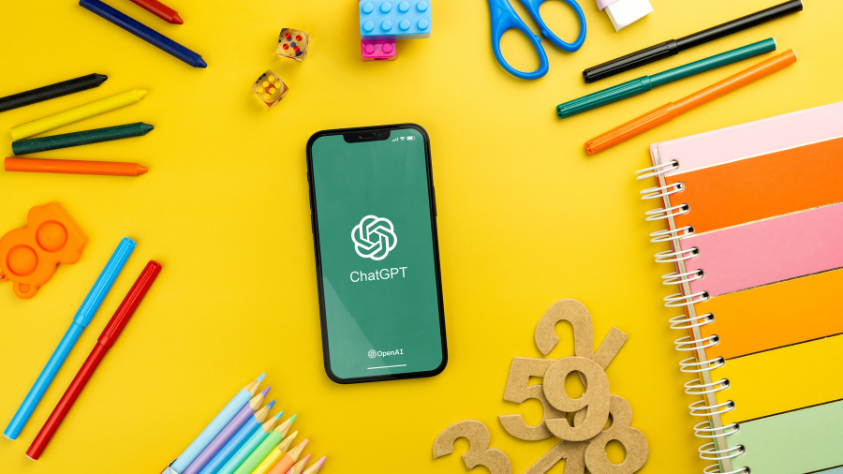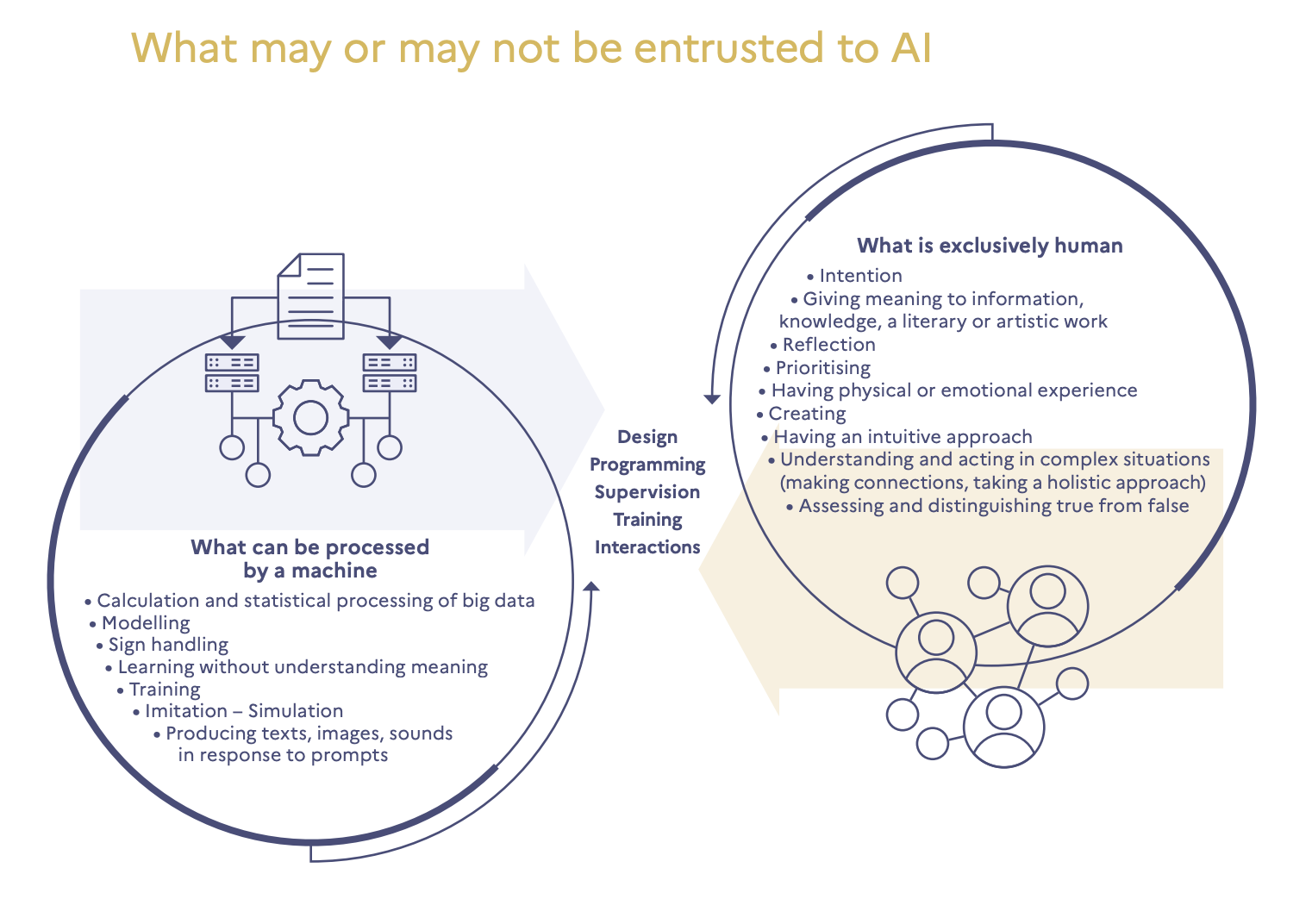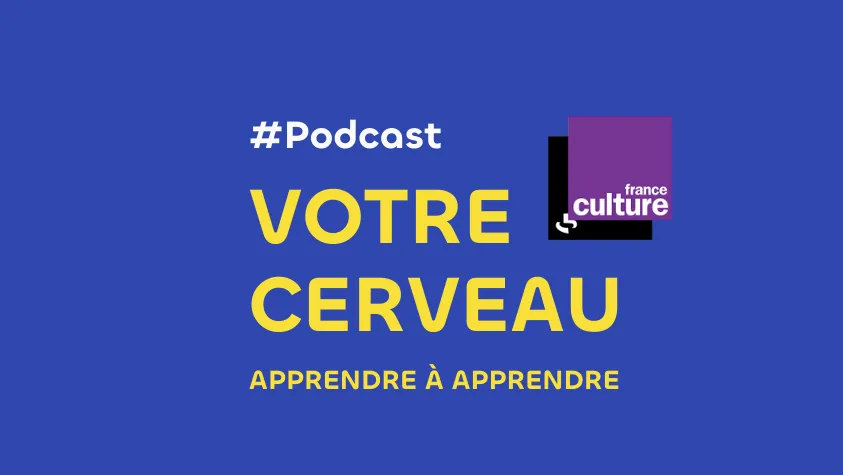
AI and education: how to use it in class?

AI: what are we talking about anyway?
Before we venture into the world of AI, let’s lay the foundations for understanding it with a few definitions.
Artificial intelligence (AI)
Artificial intelligence refers to a set of processes based on algorithms whose aim is to carry out certain more or less complex tasks, by imitating human intellectual capacities (calculation, production of texts, images etc).
Artificial intelligence vs. human intelligence
Artificial intelligence does not possess any attribute specific to human intelligence (such as emotions, self-awareness or the ability to make a decision).

Source: Artificial intellingence and education, research contribution and challenges for public policies.
Strong AI vs. Weak AI
- Strong IA: utopian, it evokes an AI with consciousness, capable of thinking and acting with autonomy equal to that of a human.
- Weak AI: artificial intelligence specialized in performing a task. It mimics particular cognitive skills, such as understanding human language or image analysis. It is currently the most widespread AI, such as ChatGPT.
Examples of AI use in our daily lives
- Chatbot
- Connected refrigerator
- Domotics
- Connected car
- Smart assistants (Siri, Alexa, etc)
- Facial recognition
- Resume analysis
- Etc.
✏ Note: artificial intelligence robots use algorithms to solve problems, but don’t have the ability to think like humans. They are indeed machines!
ChatGPT: the most famous AI tool
ChatGPT (Generative Pretrained Transformer) is an AI tool created by OpenAI, gifted to chat, write about various topics and respond to a user request called a “prompt”. This conversational agent, capable of generating content on demand, is now one of the most widely used in the world.
Why is the use of AI a concern for the world of education?
As AI becomes increasingly integrated into our lives, its impact on the field of education deserves particular attention. In particular, it raises questions about students’ relationship to knowledge: are we witnessing a profound evolution in the way we learn? Does AI enrich or impoverish the educational experience? Its adoption in educational circles is opening up a debate that oscillates between enthusiasm and caution. Questions are emerging, particularly those of an ethical and pedagogical nature.
A direct impact on learning
Pedagogically speaking, the integration of AI into classrooms invites us to rethink our traditional relationship with learning. OECD observations in 2023 in the fields of reading and mathematics reveal AI’s potential to transform the skills required on the job market and in the classroom.
Should we be worried about jobs and, by extension, education?
Faced with this reality, the OECD report raises the issue of adapting the core skills targeted by school curricula to keep “up to speed” with technological developments. This perspective imposes a reflection on our ability to integrate new skills that prepare tomorrow’s workers to use AI technologies in a constructive and enlightened way. The challenge of this reflection is not to censor the use of AI during the learning journey, but rather, to think collectively about how to prepare tomorrow’s adults for a fruitful collaboration of humans with AI.
The fear that the Brain will become “lazy”
At the heart of the debate is the risk that AI will encourage technological dependency, to the point of limiting students’ ability to learn. We can already imagine learners turning away from homework assignments, thinking “No need to do a reading sheet, I’ll ask ChatGPT to take care of it!”.
It’s legitimate to fear that our children are losing their ability to act on their own, that their Brain, deprived of effort, is going into “slacker” mode. Behind this fear, it’s the possibility of an erosion of intelligence, or even the surrender of their critical minds to machines deemed all-powerful, that frightens.
Data protection
The question of data protection also lies at the heart of the concerns raised by the unbridled development of educational technologies, particularly when these are driven by private companies rather than by the educational institutions themselves.
Who controls these technologies? And even more, what are the real educational aims behind their deployment? Thinking about the protection of students’ personal data is not just a question of computer security. It’s intrinsically linked to the very conception of education in the digital age: an education that respects the individual, fosters his or her self-fulfillment and is part of an ethical and responsible approach.
The role of the teacher
As we navigate towards AI-enhanced pedagogy, a duality is emerging: on the one hand, enthusiasm for the enrichment of knowledge offered by this technology; on the other, apprehension at the possibility that the role of the human, the teacher in this case, could be eclipsed in favor of algorithms.
So how can we take advantage of the advances that AI brings, while ensuring that teaching retains its profoundly human essence? The question is not to choose between man and machine, but rather to design a symbiosis where each plays a complementary role, to achieve a higher, more personalized and inclusive level of education. Teachers face a major challenge: that of reinventing themselves, of appropriating digital tools for which they will remain the conductor.
Control and evaluate
These technologies, capable of producing sophisticated texts and works of art, and even of passing exams in certain fields, introduce an unprecedented level of complexity into the assessment process.
For teachers, assessing work done outside the classroom is difficult, faced with the uncertainty of using ChatGPT to complete assignments. This raises the fundamental question of academic integrity and how we can distinguish work authentically produced by the student from that assisted by AI.
There is certainly a need for an open dialogue with students about the ethical use of AI in their educational journey, and for clarifying expectations of individual work and assessment.
Should ChatGPT be banned from the classroom?
The question of escaping AI, and more specifically ChatGPT already seems outdated. Banned by some schools, ChatGPT is on the contrary considered by others as a pedagogical tool.
But how do you make it your own? To support teachers, the Ministry has produced a dedicated guide, inspired by the thinking of UNESCO and the OECD. A real goldmine! See the guide “Artificial intelligence and education”.
IA in education: how to use it in class?
How can the education sector integrate these intelligent tools for the benefit of everyone, teachers and students alike?
Making AI accessible to all
To start with, it’s necessary to ensure that AI in education is marked by inclusion and equity, without discrimination: every student must have the opportunity to benefit from the opportunities offered by AI in their learning path.
Differentiating learning
Personalizing and adapting learning to the needs of each student is one of the promises of AI in education. In this way, teachers can adjust their pedagogy and adapt it to the needs of the class.
Preparing students to use AI
Elementary use of ChatGPT can often lead to generic, superficial and even obsolete answers. So why not integrate the art of “prompting” into the school curriculum? Check the sources of the information gathered, and learn to proofread and correct the content generated?
Interacting with AI encourages students to adopt an investigative posture, to cultivate their curiosity, to seek the truth, and not to settle for over-simplistic solutions. It’s by teaching students to question, criticize and refine their queries that we equip them to make the most of these tools.
In fact, the French Education Ministry is already working to develop an AI literacy competency framework to prepare students, like :
In fact, the Ministry is already working to develop an AI literacy competency framework to prepare students, like :
- Recognizing AI: recognize technological that may or may not use AI.
Understanding intelligence : analyze and critically discuss the characteristics that make an entity “intelligent”. Debate the differences between human, animal and and artificial intelligence. - Practicing interdisciplinarity: consider that there are many ways of thinking about and developing intelligent” machines. Identify a variety of technologies that use AI, including technologies covering cognitive systems, robotics and machine learning (ML).
AI strengths and weaknesses : identify the types of problems in which AI excels or does not excel. - Understanding intelligence: analyze and critically discuss the characteristics that make an entity “intelligent”. Debate the differences between human, animal and and artificial intelligence.
- Practicing interdisciplinarity: consider that there are many ways of thinking about and developing intelligent” machines. Identify a variety of technologies that use AI, including technologies covering cognitive systems, robotics and machine learning (ML).
- AI strengths and weaknesses: identify the types of problems in which AI excels or does not excel. Determine when it makes sense to use AI and when human skills are needed.
Source : Artificial intelligence and education, research contributions and chllenges for public policy (January 2024).
✏ Note : the potential integration of this framework into school curricula is a step towards preparing younger generations to work with artificial intelligence, to prepare them for the world of tomorrow.
AI: a partner for teachers?
Despite the doubts it raises, AI is also proving to be a powerful tool that is bringing its share of significant, positive changes. Artificial intelligence is indeed positioning itself in the front line to assist school teachers with missions that, while necessary, do not require direct human intervention.
Assisting with activity design
Many teachers, driven by the curiosity to evolve their practice in step with technology, have already appropriated AI tools.
Use ChatGPcreating dictations
Let’s take the example of a teacher working in a CM2 class. She plans a dictation to work on the use of the imperfect tense of first-group verbs. To make the exercise more stimulating, the teacher chooses the theme of Harry Potter. She uses ChatGPT to create the dictation script. The tool then enables her to prepare a tailor-made exercise that meets precise specifications, and frees up time for tasks with greater added value for her students (error analysis, personalized coaching to guide everyone towards progress, etc.).
A helping hand for differentiation
In this same class, he has a young pupil with a dysgraphic disorder. To adapt the work and lighten the student’s cognitive load, the teacher uses ChatGPT to prepare a gap-fill text that follows the same instructions. The AI saves her time in preparing the document, and enables her to adapt the assignment to the student’s profile, who will concentrate on the skill targeted by the dictation: spelling specific words.
Cultivating critical thinking
Artificial intelligence is a good study tool for getting students to understand why it’s important to think for themselves and not take everything at face value. By analyzing productions produced by AIs, they learn to ask (and to ask themselves) questions, to doubt what they read and to look for the answers themselves to confront them with the result.
By positioning itself as a tool at the service of educational players, AI offers promising prospects for learning that is both more accessible and enriching for the development of critical thinking.
Supporting students with disabilities
Some examples of how AI can support disabled children at school:
- Adaptive writing
- Speech-to-text translation for deaf or hard-of-hearing children
- Etc.
Beware, however, it’s necessary to temper enthusiasm for these technologies with critical reflection on their limitations. They can never replace the human expertise of a professional (a speech therapist, for example).
The Babaoo recap
Technological innovation in information access is not a new phenomenon. Access to platforms like Wikipedia or Google has, in its time, also raised concerns similar to those we’re seeing today with AI. Their integration into our daily lives has proved their value, provided, of course, that we make informed and critical use of them.
The ability to use these new tools critically and with the benefit of hindsight is a key skill that students will probably need to master right from school. In anticipation of the profound changes that AI is bringing about in education, authorities, including ministries, are working on digital literacy competency frameworks, which may well end up becoming part of school curricula.
The aim is to better prepare future generations to cohabit with AI. This approach reflects the desire to accompany technological advances with appropriate educational thinking, ensuring that tomorrow’s students are not only knowledgeable AI users, but also citizens capable of understanding and questioning the tools that shape their environment.
Babaoo’ Tip 💡
🎧 If you’d like to delve deeper into the subject, we strongly recommend the following vidéo: “How will schools respond to the A.I. revolution?”.
You may also be interested in these articles



